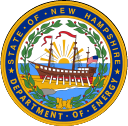Environmental Disclosure Labels - Frequently Asked Questions
Environmental disclosure labels provide information about the electric supply you receive from your utility or from a competitive energy supplier. An environmental disclosure label identifies the fuel used to generate the electricity you purchase, the air emissions resulting from that generation source, and compares those emissions to the New England regional average.
What is Environmental Disclosure?
All suppliers of electricity must provide their customers with periodic environmental disclosure statements. These statements, also called environmental disclosure labels, or EDLs, provide information on the fuels used to generate the electricity you use, the air emissions resulting from that generation of electricity, and a comparison of those emissions to a regional average.
How do electricity suppliers report renewable energy?
Utilities throughout New England are required to increase the percentage of renewable energy in their generation supply mix each year pursuant to the state’s Renewable Portfolio Standard law, RSA 362-F. In order to do that, utilities and power suppliers acquire Renewable Energy Certificates (RECs) produced by eligible renewable power generators. Payments made for RECs help renewable generators compete with non-renewable fuels.
What Information Do the Environmental Disclosure Labels Provide?
Environmental disclosure labels provide you with information about the impact of the electricity you purchase, whether from your utility or from a competitive energy supplier. The environmental disclosure label is designed to help you understand how producing electricity affects the environment and public health.
The Environmental Disclosure Label provides information on three air emissions: sulfur dioxide (SO2), nitrogen oxides (NOx) and carbon dioxide (CO2).
Sulfur Dioxide (SO2) is a heavy, colorless gas that contributes to acid rain. Electric generation facilities that burn fossil fuels are the largest source of SO2 emissions. SO2 emissions are controlled and monitored by federal and state environmental regulatory programs.
Nitrogen Oxides (NOx) are compounds of nitrogen and oxygen that contribute to acid rain and ground-level ozone. Electric generation facilities that burn fossil or biomass fuels are a major source of NOx emissions. NOx emissions are controlled and monitored by federal and state environmental regulatory programs.
Carbon Dioxide (CO2) is a colorless, odorless gas that allows light from the sun's rays to be transmitted to the Earth's surface but blocks heat radiating from the Earth's surface from escaping into the atmosphere, contributing to global climate change or warming due to the "greenhouse" effect. Electric generation facilities that burn fossil fuels are a major source of CO2 emissions. CO2 emissions are monitored by federal and state environmental programs.
In addition to the three air emissions identified on the EDL, certain fuels release particulate matter and mercury when burned to produce electricity. These two pollutants have health impacts particularly to sensitive populations such as those with respiratory diseases, children, and the elderly.
Learn more about ground-level ozone, climate change, acid rain and other pollutants such as particulates and mercury.
How does the Environmental Label Relate to the New Hampshire’s Renewable Portfolio Standard?
The New Hampshire Renewable Portfolio Standard (RPS) law, RSA 362-F, requires each electricity provider to meet customer load by purchasing or acquiring certificates representing generation from renewable energy based on total megawatt-hours supplied. Renewable energy certificates, or RECs, are issued by the administrator of the ISO New England Generation Information System (GIS), which is used to track the renewable attributes of electrical generation in New England. Some of the renewable energy listed on a disclosure label may be meeting a supplier’s legal obligation under New Hampshire’s Renewable Portfolio Standard.
What are Renewable Energy Certificates?
Renewable energy certificates, RECS, are an electronic record showing that one unit of eligible renewable electricity has been generated. In New Hampshire and surrounding states, the unit is equal to one MWh. Renewable Energy Certificates are managed through the New England Power Pool Generation Information System (NEPOOL GIS). The certificates created from eligible renewable energy generation are sold on this regional market and are retired throughout New England. Utilities and power suppliers acquire Renewable Energy Certificates produced by eligible/certified renewable power generators to meet New Hampshire’s RPS.



